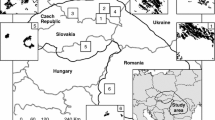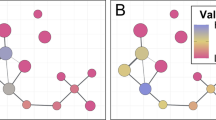Abstract
Least-cost modelling is becoming widely used in landscape ecology to examine functional connectivity. Traditionally the least-cost modelling algorithm creates a regularly structured landscape graph for connectivity analysis by converting all the cells from a cost-surface into vertices in a landscape graph. However, use of a regular landscape graph is problematic as it: contains a great deal of redundant information that in turn increases processing times, is constructed in a deterministic manner that precludes examination of the effects of graph structure on connectivity measures, and is known to produce results with directional bias. I present, and provide Python code for, an algorithm to produce an irregular landscape graph from a cost-surface. Tests demonstrate that comparable results to those of the traditional regular landscape graph approach can be achieved, while at the same time reducing computational expense, enabling variations in graph structure to be incorporated into an analysis, and avoiding directional bias. Therefore, this approach may allow for more robust ecological decision-making when examining matters of functional connectivity using least-cost modelling.








Similar content being viewed by others

References
Adriaensen F, Chardon JP, De Blust G, Swinnen E, Villalba S, Gulinck H, Matthysen E (2003) The application of ‘least-cost’ modelling as a functional landscape model. Landscape Urban Plan 64:233–247
Beier P, Majka DR, Newell SL (2009) Uncertainty analysis of least-cost modeling for designing wildlife linkages. Ecol Appl 19:2067–2077
Burrough PA, McDonnell RA (1998) Principles of geographical information systems. Oxford University Press, Oxford
Cantwell MD, Forman RTT (1993) Landscape graph: ecological modeling with graph theory to detect configurations common to diverse landscapes. Landscape Ecol 8:239–255
Chen Z-T, Guevara JA (1987) Systematic selection of very important points (VIP) from digital terrain model for constructing triangular irregular networks. In: Chrisman NR (ed) AUTO-CARTO 8: proceedings of the international symposium on computer-assisted cartography, Baltimore
Dijkstra EW (1959) A note on two problems in connexion with graphs. Numer Math 1:269–271
Douglas DH (1994) Least-cost path in GIS using an accumulated cost surface and slopelines. Cartographica 31:37–51
Dunn AG (2010) Grid-induced biases in connectivity metric implementations that use regular grids. Ecography 33:627–631
Etherington TR (2012) Mapping organism spread potential by integrating dispersal and transportation processes using graph theory and catchment areas. Int J Geogr Inf Sci 26:541–556
Fall A, Fortin M-J, Manseau M, O’Brien D (2007) Spatial graphs: principles and applications for habitat connectivity. Ecosystems 10:448–461
Fortin M-J, Dale MRT (2005) Spatial analysis: a guide for ecologists. Cambridge University Press, New York
Gonzales EK, Gergel SE (2007) Testing assumptions of cost surface analysis—a tool for invasive species management. Landscape Ecol 22:1155–1168
Gross JL, Yellen J, Beineke LW, Wilson RJ (2004) Introduction to graphs. In: Gross JL, Yellen J (eds) Handbook of graph theory. CRC Press, Boca Raton, pp 1–55
Hagberg AA, Schult DA, Swart PJ (2008) Exploring network structure, dynamics, and function using NetworkX. In: Varoquaux G, Vaught T, Millman J (eds) Proceedings of the 7th annual python in science conference, Pasadena
Holland EP, Aegerter JN, Dytham C, Smith GC (2007) Landscape as a model: the importance of geometry. PLoS Comput Biol 3:1979–1992
Lee J (1991) Comparison of existing methods for building triangular irregular network models of terrain from grid elevation models. Int J Geogr Inf Sci 5:267–285
Moilanen A (2011) On the limitations of graph-theoretic connectivity in spatial ecology and conservation. J Appl Ecol 48:1543–1547
Oliphant TE (2007) Python for scientific computing. Comput Sci Eng 9:10–20
O’Sullivan D, Unwin DJ (2010) Geographic information analysis. Wiley, Hoboken
Pinto N, Keitt TH (2009) Beyond the least-cost path: evaluating corridor redundancy using a graph-theoretic approach. Landscape Ecol 24:253–266
Rayfield B, Fortin M-J, Fall A (2010) The sensitivity of least-cost habitat graphs to relative cost surface values. Landscape Ecol 25:519–532
Schadt S, Knauer F, Kaczensky P, Revilla E, Wiegand T, Trepl L (2002) Rule-based assessment of suitable habitat and patch connectivity for the Eurasian lynx. Ecol Appl 12:1469–1483
Tischendorf L, Fahrig L (2000) On the usage and measurement of landscape connectivity. Oikos 90:7–19
Tomlin D (2010) Propagating radial waves of travel cost in a grid. Int J Geogr Inf Sci 24:1391–1413
Turner MG, Gardner RH, O’Neill RV (2001) Landscape ecology in theory and practice: pattern and process. Springer, New York
Urban DL, Minor ES, Treml EA, Schick RS (2009) Graph models of habitat mosaics. Ecol Lett 12:260–273
Xu JP, Lathrop RG (1995) Improving simulation accuracy of spread phenomena in a raster-based geographic information system. Int J Geogr Inf Sci 9:153–168
Acknowledgments
Funding was provided by the New Zealand Government as a New Zealand International Doctoral Research Scholarship, and by The University of Auckland as a The University of Auckland Plus—NZIDRS Plus scholarship. Thanks to George Perry for help in improving the manuscript.
Author information
Authors and Affiliations
Corresponding author
Rights and permissions
About this article
Cite this article
Etherington, T.R. Least-cost modelling on irregular landscape graphs. Landscape Ecol 27, 957–968 (2012). https://doi.org/10.1007/s10980-012-9747-y
Received:
Accepted:
Published:
Issue Date:
DOI: https://doi.org/10.1007/s10980-012-9747-y



